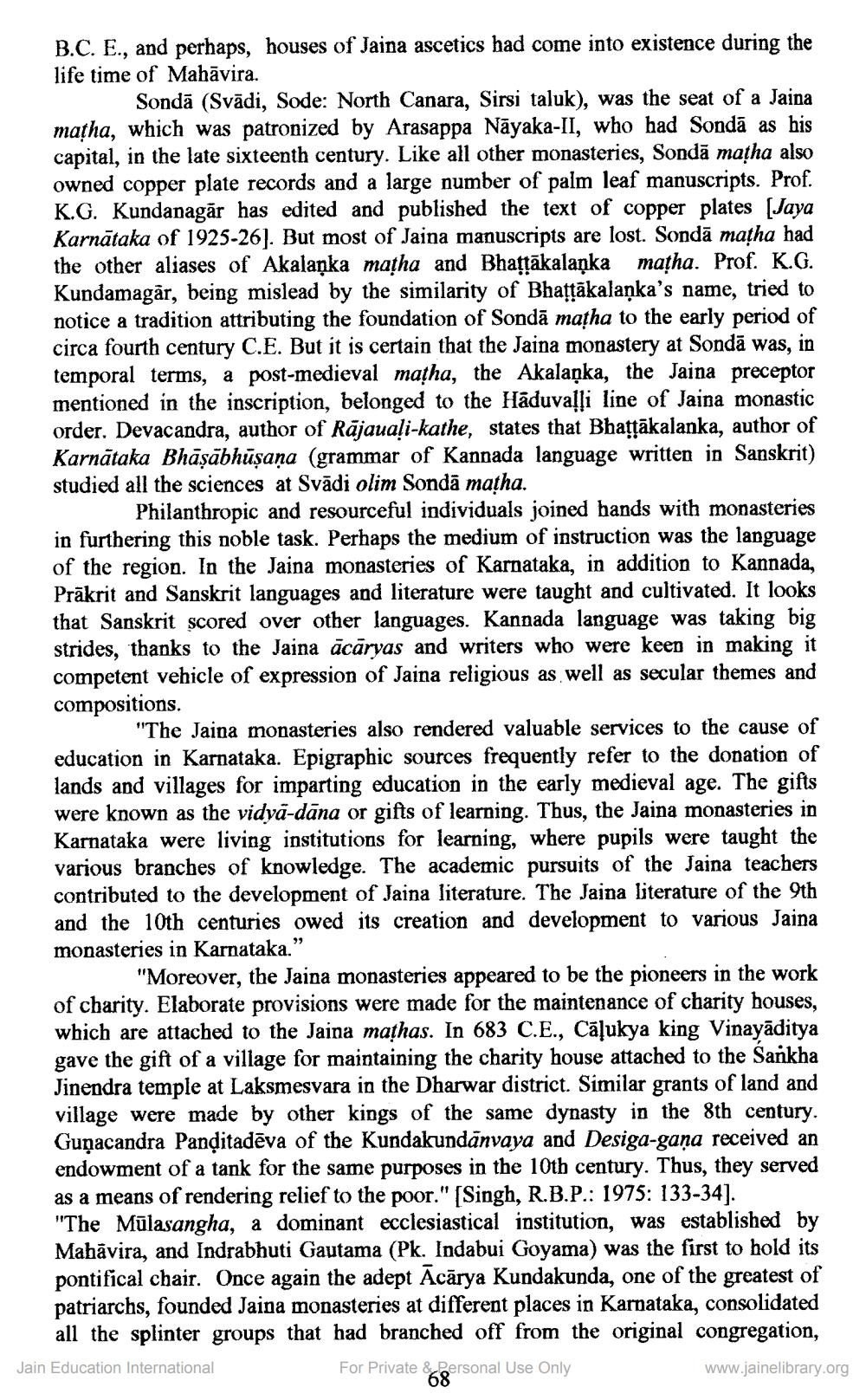________________
B.C. E., and perhaps, houses of Jaina ascetics had come into existence during the life time of Mahāvira.
Sondā (Svādi, Sode: North Canara, Sirsi taluk), was the seat of a Jaina matha, which was patronized by Arasappa Nāyaka-II, who had Sondā as his capital, in the late sixteenth century. Like all other monasteries, Sondā mațha also owned copper plate records and a large number of palm leaf manuscripts. Prof. K.G. Kundanagār has edited and published the text of copper plates (Jaya Karnātaka of 1925-26). But most of Jaina manuscripts are lost. Sondā mațha had the other aliases of Akalanka matha and Bhattākalanka matha. Prof. K.G. Kundamagār, being mislead by the similarity of Bhattākalanka's name, tried to notice a tradition attributing the foundation of Sondā matha to the early period of circa fourth century C.E. But it is certain that the Jaina monastery at Sondā was, in temporal terms, a post-medieval matha, the Akalaņka, the Jaina preceptor mentioned in the inscription, belonged to the Häduvalli line of Jaina monastic order. Devacandra, author of Rājauali-kathe, states that Bhattākalanka, author of Karnātaka Bhāṣābhūșaņa (grammar of Kannada language written in Sanskrit) studied all the sciences at Svādi olim Sondā matha.
Philanthropic and resourceful individuals joined hands with monasteries in furthering this noble task. Perhaps the medium of instruction was the language of the region. In the Jaina monasteries of Karnataka, in addition to Kannada, Prākrit and Sanskrit languages and literature were taught and cultivated. It looks that Sanskrit scored over other languages. Kannada language was taking big strides, thanks to the Jaina ācāryas and writers who were keen in making it competent vehicle of expression of Jaina religious as well as secular themes and compositions.
"The Jaina monasteries also rendered valuable services to the cause of education in Karnataka. Epigraphic sources frequently refer to the donation of lands and villages for imparting education in the early medieval age. The gifts were known as the vidyā-dāna or gifts of learning. Thus, the Jaina monasteries in Karnataka were living institutions for learning, where pupils were taught the various branches of knowledge. The academic pursuits of the Jaina teachers contributed to the development of Jaina literature. The Jaina literature of the 9th and the 10th centuries owed its creation and development to various Jaina monasteries in Karnataka."
"Moreover, the Jaina monasteries appeared to be the pioneers in the work of charity. Elaborate provisions were made for the maintenance of charity houses, which are attached to the Jaina mațhas. In 683 C.E., Cāļukya king Vinayāditya gave the gift of a village for maintaining the charity house attached to the Sankha Jinendra temple at Laksmesvara in the Dharwar district. Similar grants of land and village were made by other kings of the same dynasty in the 8th century. Guņacandra Panditadēva of the Kundakundānvaya and Desiga-gana received an endowment of a tank for the same purposes in the 10th century. Thus, they served as a means of rendering relief to the poor." (Singh, R.B.P.: 1975: 133-34). "The Mūlasangha, a dominant ecclesiastical institution, was established by Mahāvira, and Indrabhuti Gautama (Pk. Indabui Goyama) was the first to hold its pontifical chair. Once again the adept Ācārya Kundakunda, one of the greatest of patriarchs, founded Jaina monasteries at different places in Karnataka, consolidated
all the splinter groups that had branched off from the original congregation, Jain Education International For Private Personal Use Only
www.jainelibrary.org




